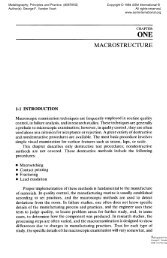A0004222_Titlepage 1..1 - ASM International
A0004222_Titlepage 1..1 - ASM International
A0004222_Titlepage 1..1 - ASM International
You also want an ePaper? Increase the reach of your titles
YUMPU automatically turns print PDFs into web optimized ePapers that Google loves.
© 2006 <strong>ASM</strong> <strong>International</strong>. All Rights Reserved.<br />
<strong>ASM</strong> Handbook, Volume 13C, Corrosion: Environments and Industries (#05145)<br />
Foreword<br />
This work, Corrosion: Environments and Industries, is application driven. The best practices in segments<br />
of industry with respect to materials selection, protection of materials, and monitoring of corrosion<br />
are presented. The challenges of local environments encountered within these industries, as well as largescale<br />
environmental challenges, are documented. The choice of solutions to these challenges can be<br />
found.<br />
Just as the environment affects materials, so also corrosion and its by-products affect the immediate<br />
environment. Nowhere is the immediate effect of more concern than in biomedical implants. We are<br />
pleased with the new information shared by experts in this field.<br />
As we recognize the energy costs of producing new materials of construction, the creation of engineered<br />
systems that will resist corrosion takes on added importance. The importance and costs of<br />
maintenance have been discussed for many of the industrial segments—aviation, automotive, oil and gas<br />
pipeline, chemical, and pulp and paper industries, as well as the military. The consequences of material<br />
degradation are addressed as the service temperatures of materials are pushed higher for greater efficiency<br />
in energy conversion. As engineered systems are made more complex and the controlling electronics are<br />
made smaller, the tolerance for any corrosion is lessened.<br />
<strong>ASM</strong> <strong>International</strong> is deeply indebted to the Editors, Stephen D. Cramer and Bernard S. Covino, Jr.,<br />
who envisioned the revision of the landmark 1987 Metals Handbook, 9th edition, Volume 13. The energy<br />
they sustained throughout this project and the care they gave to every article has been huge. The resulting<br />
three Volumes contain 281 articles, nearly 3000 pages, 3000 figures, and 1500 tables––certainly<br />
impressive statistics. Our Society is as impressed and equally grateful for the way in which they recruited<br />
and encouraged a community of corrosion experts from around the world and from many professional<br />
organizations to volunteer their time and ability.<br />
We are grateful to the 200 authors and reviewers who shared their knowledge of corrosion and materials<br />
for the good of this Volume. They are listed on the next several pages. And again, thanks to the contributors<br />
to the preceding two Volumes and the original 9th edition Corrosion Volume.<br />
Thanks also go to the members of the <strong>ASM</strong> Handbook Committee for their involvement in this project<br />
and their commitment to keep the information of the <strong>ASM</strong> Handbook series current and relevant to the<br />
needs of our members and the technical community. Finally, thanks to the <strong>ASM</strong> editorial and production<br />
staff for the overall result.<br />
iii<br />
Reza Abbaschian<br />
President<br />
<strong>ASM</strong> <strong>International</strong><br />
Stanley C. Theobald<br />
Managing Director<br />
<strong>ASM</strong> <strong>International</strong><br />
www.asminternational.org

















